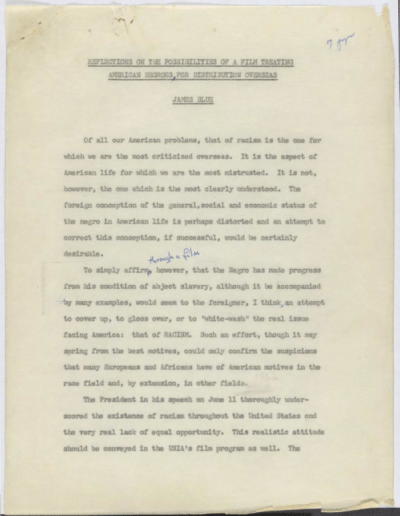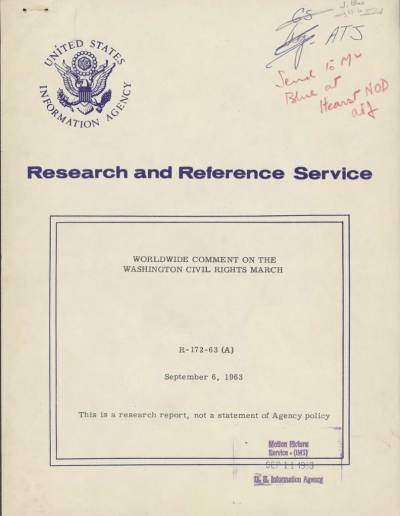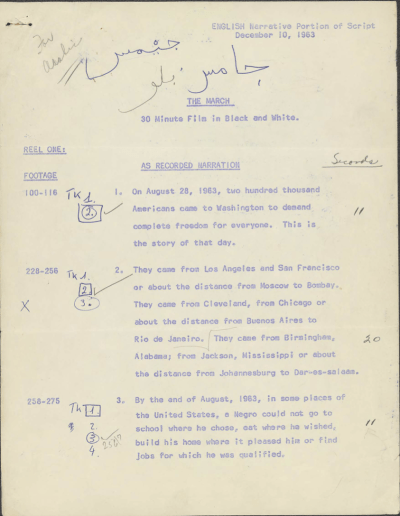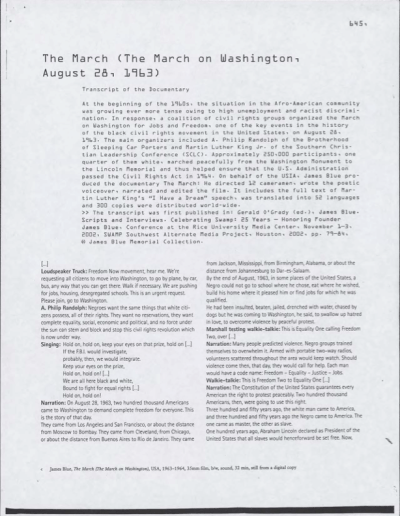The Making of The March
Furnished with 15 cameramen and a $50,000 budget, James Blue was appointed to direct the USIA documentary of the August 28, 1963, March on Washington.
The Selection of James Blue as Director
George Stevens, Jr., who served Edward R. Murrow as director of the USIA’s Motion Picture Service, had seen and admired Blue’s Les oliviers de la justice at the 1962 Cannes Film Festival. The film won the Critics’ Prize for its lyrical portrayal of a family ensnared in the Algerian civil war, caught between the pied noirs and the National Liberation Front (FLN). (A US film would not win this award again until Apocalypse Now in 1979).
Stevens hired Blue in 1962 to direct documentaries for the USIA and assigned him the responsibility of filming the March on Washington because Stevens felt Blue would provide a “humanistic and poetic” framing of the event.[1] Murrow and Stevens envisioned a documentary on the March on Washington, then in its planning stages, as an opportunity for the USIA to offer a positive image of the United States to the world community. America’s race problem was the major issue faced by the USIA in confronting the Soviet Union’s propaganda. In a January 17, 1964, letter to President Johnson, Murrow wrote that The March was “probably the finest argument for peaceful petition of redress of grievance that has ever been put on film.”[2]
Preparing for the Film
The following documents reveal how James Blue prepared for and then filmed the March on Washington. Blue, according to the materials in his personal archive, conducted a significant study of the problem of race in the United States. He kept careful track of the problems encountered by Blacks during the summer of 1963. George Stevens, Jr., who helped develop and frame Blue’s project, provided Blue with the resources needed to stage the film. Below you can explore selected documents that reveal how Blue prepared to direct the film and the subsequent efforts to translate the film for a global audience.
World Media Reaction to President Kennedy’s Civil Rights Speeches
“World Media Reaction to President Kennedy’s Civil Rights Speeches (USIA Report R-113-63 [A]),” James Blue papers, Coll 458, Box 61, Folder 6, Special Collections and University Archives, University of Oregon Libraries, Eugene, Oregon. Public domain.
Reflections on the Possibilities of a Film Treating American Negroes for Distribution Overseas
“Reflections on the Possibilities of a Film Treating American Negroes for Distribution Overseas,” James Blue papers, Coll 458, Box 66, Folder 58, Special Collections and University Archives, University of Oregon Libraries, Eugene, Oregon. Copyright Richard Blue. Reproduced with permission.
Worldwide Comment on the Washington Civil Rights March
“Worldwide Comment on the Washington Civil Rights March (USIA R-172-73 [A]),” James Blue papers, Coll 458, Box 61, Folder 12, Special Collections and University Archives, University of Oregon Libraries, Eugene, Oregon. Public domain.
The March, English Narrative Portion of Script
“The March, English Narrative Portion of Script,” James Blue papers, Coll 458, Box 61, Folder 7, Special Collections and University Archives, University of Oregon Libraries, Eugene, Oregon. Copyright Richard Blue. Reproduced with permission.
The March (The March on Washington, August 28, 1963) Transcript
“The March (The March on Washington, August 28, 1963),” James Blue papers, Coll 458, Box 112, Folder 5, Special Collections and University Archives, University of Oregon Libraries, Eugene, Oregon. Copyright Richard Blue. Reproduced with permission.
Archival Documents
“World Media Reaction to President Kennedy’s Civil Rights Speeches (USIA Report R-113-63 [A]),” James Blue papers, Coll 458, Box 61, Folder 6, Special Collections and University Archives, University of Oregon Libraries, Eugene, Oregon. Public domain.
“Reflections on the Possibilities of a Film Treating American Negroes for Distribution Overseas,” James Blue papers, Coll 458, Box 66, Folder 58, Special Collections and University Archives, University of Oregon Libraries, Eugene, Oregon. Copyright Richard Blue. Reproduced with permission.
“Worldwide Comment on the Washington Civil Rights March (USIA R-172-73 [A]),” James Blue papers, Coll 458, Box 61, Folder 12, Special Collections and University Archives, University of Oregon Libraries, Eugene, Oregon. Public domain.
“The March, English Narrative Portion of Script,” James Blue papers, Coll 458, Box 61, Folder 7, Special Collections and University Archives, University of Oregon Libraries, Eugene, Oregon. Copyright Richard Blue. Reproduced with permission.
“THE MARCH — 30 minute — Black and White, To Be Recorded Narration,” James Blue papers, Coll 458, Box 61, Folder 7, Special Collections and University Archives, University of Oregon Libraries, Eugene, Oregon. Copyright Richard Blue. Reproduced with permission.
“The March (The March on Washington, August 28, 1963),” James Blue papers, Coll 458, Box 112, Folder 5, Special Collections and University Archives, University of Oregon Libraries, Eugene, Oregon. Copyright Richard Blue. Reproduced with permission.





